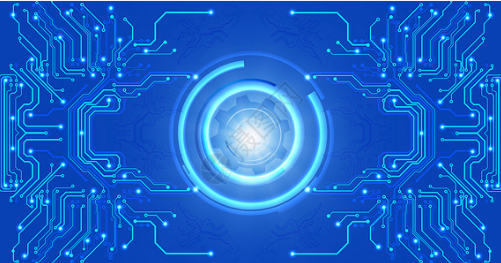As PCB designers, we will always encounter all kinds of questions whether in study or work. Of course you have to answer if you have any questions! In this article, Banermei shares three difficult questions and answers related to PCB design with you, hoping to be helpful to everyone's study and work.
1. What are the types of signal wires in PCB and what are the differences?
Answer: There are two types of signal lines in PCB, one is microstrip line and the other is strip line.
Microstrip line: It is a strip line that runs on the surface layer (microstrip) and is attached to the surface of the PCB. As shown in the figure below, the blue part is the conductor, the green part is the insulating dielectric of the PCB, and the blue block above is Microstrip line. Because one side of the microstrip line is exposed in the air, it can form radiation or be interfered by the surrounding radiation, and the other side is attached to the insulating dielectric of the PCB, so part of the electric field formed by it is distributed in the air, and the other part Distributed in the insulating medium of the PCB. However, the signal transmission speed in the microstrip line is faster than the signal transmission speed in the stripline (stripline), which is its outstanding advantage.

Stripline: The stripline/double stripline is embedded in the inner layer of the PCB. As shown in the figure below, the blue part is the conductor, the green part is the insulating dielectric of the PCB, and the stripline is embedded in two layers. Ribbon wire between conductors. Because the stripline is embedded between two layers of conductors, its electric field is distributed between the two conductors (planes) enclosing it, and it will not radiate energy, nor will it be interfered by external radiation. However, because it is surrounded by dielectric materials (the dielectric constant is greater than 1), the signal transmission speed in the stripline is slower than in the microstrip line.
2. How does PCB prevent the interference of PWM and other mutation signals on analog signals (such as op amps), and how to test the magnitude of such interference (radiation interference or conduction interference)? In addition to the layout and routing needs to pay attention to, are there other ways to suppress (except for shielding)?
Answer: Starting from several interfaces of the op amp, the input terminal should prevent spatial coupling interference and PCB crosstalk (layout improvement); the power supply requires decoupling capacitors of different capacitance values. The test can use the probe of the oscilloscope to test the position mentioned above to determine where the interference comes from. If the PWM signal is turned into a DC control voltage through low-pass filtering, you can consider filtering it, or connect a small capacitor to the ground in parallel to make the PWM waveform round and reduce high-frequency components.
3. How to reflect the 3W principle and 20H principle in PCB design?
Answer: First, the 3W principle is easily reflected in PCB design. It is sufficient to ensure that the center distance between the trace and the trace is 3 times the line width. For example, the line width of the trace is 6 mils, then in order to meet the 3W principle Allegro can set the line-to-line rule to 12mil, and the spacing in the software is to calculate the edge-to-edge spacing
Second, the 20H principle. In the PCB design, in order to reflect the 20H principle, we generally need to shrink the power layer 1mm from the ground layer when the plane layer is divided. Then punch a shielding via hole on the 1mm inner shrinkable tape, one 150mil.
In order to reduce the crosstalk between lines, the line spacing should be large enough. When the line center spacing is not less than 3 times the line width, 70% of the electric field can be maintained without mutual interference, which is called the 3W rule. If you want to achieve 98% of the electric field without interfering with each other, you can use a spacing of 10W.
Since the electric field between the power layer and the ground layer is changing, electromagnetic interference will radiate outward from the edge of the board. It is called the edge effect. The solution is to shrink the power layer so that the electric field is only conducted within the ground layer. Taking a H (the thickness of the medium between the power supply and the ground) as a unit, if the shrinkage is 20H, 70% of the electric field can be confined to the edge of the ground layer; if the shrinkage is 100H, 98% of the electric field can be confined.